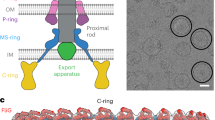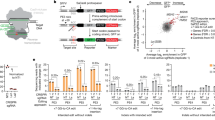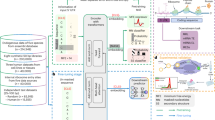Abstract
Elongation factor eEF3 is an ATPase that, in addition to the two canonical factors eEF1A and eEF2, serves an essential function in the translation cycle of fungi. eEF3 is required for the binding of the aminoacyl-tRNA–eEF1A–GTP ternary complex to the ribosomal A-site and has been suggested to facilitate the clearance of deacyl-tRNA from the E-site. Here we present the crystal structure of Saccharomyces cerevisiae eEF3, showing that it consists of an amino-terminal HEAT repeat domain, followed by a four-helix bundle and two ABC-type ATPase domains, with a chromodomain inserted in ABC2. Moreover, we present the cryo-electron microscopy structure of the ATP-bound form of eEF3 in complex with the post-translocational-state 80S ribosome from yeast. eEF3 uses an entirely new factor binding site near the ribosomal E-site, with the chromodomain likely to stabilize the ribosomal L1 stalk in an open conformation, thus allowing tRNA release.
This is a preview of subscription content, access via your institution
Access options
Subscribe to this journal
Receive 51 print issues and online access
$199.00 per year
only $3.90 per issue
Buy this article
- Purchase on Springer Link
- Instant access to full article PDF
Prices may be subject to local taxes which are calculated during checkout




Similar content being viewed by others
References
Kovalchuke, O., Kambampati, R., Pladies, E. & Chakraburtty, K. Competition and cooperation among yeast elongation factors. Eur. J. Biochem. 258, 986–993 (1998)
Gontarek, R. R., Li, H., Nurse, K. & Prescott, C. D. The N terminus of eukaryotic translation elongation factor 3 interacts with 18S rRNA and 80S ribosomes. J. Biol. Chem. 273, 10249–10252 (1998)
Kambampati, R. et al. Limited proteolysis of yeast elongation factor 3. Sequence and location of the subdomains. J. Biol. Chem. 275, 16963–16968 (2000)
Triana-Alonso, F. J., Chakraburtty, K. & Nierhaus, K. H. The elongation factor 3 unique in higher fungi and essential for protein biosynthesis is an E site factor. J. Biol. Chem. 270, 20473–20478 (1995)
Kamath, A. & Chakraburtty, K. Role of yeast elongation factor 3 in the elongation cycle. J. Biol. Chem. 264, 15423–15428 (1989)
Jones, P. M. & George, A. M. Mechanism of ABC transporters: a molecular dynamics simulation of a well characterized nucleotide-binding subunit. Proc. Natl Acad. Sci. USA 99, 12639–12644 (2002)
Frank, J. & Agrawal, R. K. A ratchet-like inter-subunit reorganization of the ribosome during translocation. Nature 406, 318–322 (2000)
Gomez-Lorenzo, M. G. et al. Three-dimensional cryo-electron microscopy localization of EF2 in the Saccharomyces cerevisiae 80S ribosome at 17.5 Å resolution. EMBO J. 19, 2710–2718 (2000)
Valle, M. et al. Locking and unlocking of ribosomal motions. Cell 114, 123–134 (2003)
Harms, J. et al. High resolution structure of the large ribosomal subunit from a mesophilic eubacterium. Cell 107, 679–688 (2001)
Morgan, D. G., Menetret, J. F., Neuhof, A., Rapoport, T. A. & Akey, C. W. Structure of the mammalian ribosome–channel complex at 17 Å resolution. J. Mol. Biol. 324, 871–886 (2002)
Andersen, C. F. et al. Purification and crystallization of the yeast translation elongation factor eEF3. Acta Crystallogr. D 60, 1304–1307 (2004)
Andrade, M. A., Petosa, C., O'Donoghue, S. I., Muller, C. W. & Bork, P. Comparison of ARM and HEAT protein repeats. J. Mol. Biol. 309, 1–18 (2001)
Groves, M. R., Hanlon, N., Turowski, P., Hemmings, B. A. & Barford, D. The structure of the protein phosphatase 2A PR65/A subunit reveals the conformation of its 15 tandemly repeated HEAT motifs. Cell 96, 99–110 (1999)
Locher, K. P., Lee, A. T. & Rees, D. C. The E. coli BtuCD structure: a framework for ABC transporter architecture and mechanism. Science 296, 1091–1098 (2002)
Smith, P. C. et al. ATP binding to the motor domain from an ABC transporter drives formation of a nucleotide sandwich dimer. Mol. Cell 10, 139–149 (2002)
Chang, G. & Roth, C. B. Structure of MsbA from E. coli: a homolog of the multidrug resistance ATP binding cassette (ABC) transporters. Science 293, 1793–1800 (2001)
Hopfner, K. P. et al. Structural biology of Rad50 ATPase: ATP-driven conformational control in DNA double-strand break repair and the ABC-ATPase superfamily. Cell 101, 789–800 (2000)
Holm, L. & Sander, C. Mapping the protein universe. Science 273, 595–603 (1996)
Brehm, A., Tufteland, K. R., Aasland, R. & Becker, P. B. The many colours of chromodomains. Bioessays 26, 133–140 (2004)
Beckmann, R. et al. Architecture of the protein-conducting channel associated with the translating 80S ribosome. Cell 107, 361–372 (2001)
Kambampati, R. & Chakraburtty, K. Functional subdomains of yeast elongation factor 3. Localization of ribosome-binding domain. J. Biol. Chem. 272, 6377–6381 (1997)
Spahn, C. M. et al. Domain movements of elongation factor eEF2 and the eukaryotic 80S ribosome facilitate tRNA translocation. EMBO J. 23, 1008–1019 (2004)
Robinson, H. et al. The hyperthermophile chromosomal protein Sac7d sharply kinks DNA. Nature 392, 202–205 (1998)
Stein, A. J., Fuchs, G., Fu, C., Wolin, S. L. & Reinisch, K. M. Structural insights into RNA quality control: the Ro autoantigen binds misfolded RNAs via its central cavity. Cell 121, 529–539 (2005)
Yusupov, M. M. et al. Crystal structure of the ribosome at 5.5 Å resolution. Science 292, 883–896 (2001)
Ogle, J. M. & Ramakrishnan, V. Structural insights into translational fidelity. Annu. Rev. Biochem. 74, 129–177 (2005)
Reyes, C. L. & Chang, G. Structure of the ABC transporter MsbA in complex with ADP·vanadate and lipopolysaccharide. Science 308, 1028–1031 (2005)
Sarthy, A. V. et al. High-level overexpression of yeast elongation factor 3 and detailed kinetic analysis using a coupled spectrophotometric assay. Anal. Biochem. 254, 288–290 (1997)
Higgins, C. F. & Linton, K. J. The ATP switch model for ABC transporters. Nature Struct. Mol. Biol. 11, 918–926 (2004)
Terwilliger, T. SOLVE and RESOLVE: automated structure solution, density modification and model building. J. Synchrotron Radiat. 11, 49–52 (2004)
Jones, T. A., Cowan, S., Zou, J.-Y. & Kjeldgaard, M. Improved methods for building protein models in electron density maps and the location of errors in these models. Acta Crystallogr. A 47, 110–119 (1991)
Brunger, A. T. et al. Crystallography & NMR system: a new software suite for macromolecular structure determination. Acta Crystallogr. D 54, 905–921 (1998)
Kabsch, W. in International Tables for Crystallography (ed. Arnold, E.) Ch. 25.2.9 (Kluwer Academic, Dordrecht, 2001)
Pedersen, J. S. A flux- and background-optimized version of the NanoSTAR small-angle X-ray scattering camera for solution scattering. J. Appl. Cryst. 37, 369–380 (2004)
Svergun, D. I., Barberato, C. & Koch, M. H. J. CRYSOL—a program to evaluate X-ray solution scattering of biological macromolecules from atomic coordinates. J. Appl. Cryst. 28, 768–773 (1995)
Svergun, D. I., Petoukhov, M. V. & Koch, M. H. J. Determination of domain structure of proteins from X-ray solution scattering. Biophys. J. 80, 2946–2953 (2001)
Beckmann, R. et al. Alignment of conduits for the nascent polypeptide chain in the ribosome–Sec61 complex. Science 278, 2123–2126 (1997)
Halic, M. et al. Structure of the signal recognition particle interacting with the elongation-arrested ribosome. Nature 427, 808–814 (2004)
Wagenknecht, T., Grassucci, R. & Frank, J. Electron microscopy and computer image averaging of ice-embedded large ribosomal subunits from Escherichia coli. J. Mol. Biol. 199, 137–147 (1988)
Frank, J. et al. SPIDER and WEB: processing and visualization of images in 3D electron microscopy and related fields. J. Struct. Biol. 116, 190–199 (1996)
Yuan, Y. R. et al. The crystal structure of the MJ0796 ATP-binding cassette. Implications for the structural consequences of ATP hydrolysis in the active site of an ABC transporter. J. Biol. Chem. 276, 32313–32321 (2001)
Karcher, A., Buttner, K., Martens, B., Jansen, R. P. & Hopfner, K. P. X-ray structure of RLI, an essential twin cassette ABC ATPase involved in ribosome biogenesis and HIV capsid assembly. Structure (Camb.) 13, 649–659 (2005)
Spahn, C. M. et al. Structure of the 80S ribosome from Saccharomyces cerevisiae—tRNA–ribosome and subunit–subunit interactions. Cell 107, 373–386 (2001)
Mueller, F. et al. Getting closer to an understanding of the three-dimensional structure of ribosomal RNA. Biochem. Cell Biol. 73, 767–773 (1995)
Wriggers, W., Milligan, R. A. & McCammon, J. A. Situs: a package for docking crystal structures into low-resolution maps from electron microscopy. J. Struct. Biol. 125, 185–195 (1999)
Lu, G., Westbrooks, J. M., Davidson, A. L. & Chen, J. ATP hydrolysis is required to reset the ATP-binding cassette dimer into the resting-state conformation. Proc. Natl Acad. Sci. USA 102, 17969–17974 (2005)
DeLano, W. L. The PyMOL User's Manual (DeLano Scientific, San Carlos, California, 2002)
Pettersen, E. F. et al. UCSF Chimera—a visualization system for exploratory research and analysis. J. Comput. Chem. 25, 1605–1612 (2004)
Acknowledgements
G.R.A. was supported by the NIH, HFSP, EU FP5 and SNF. T.G.K. was supported by the NIH and HFSP. We are grateful to I. Kerr and D. Brodersen for discussions, and to L. Van for technical assistance. The work was further supported by grants from the VolkswagenStiftung (to R.B. and C.M.T.S.), the Deutsche Forschungsgemeinschaft (to R.B.), and by the European Union and Senatsverwaltung für Wissenschaft, Forschung und Kultur Berlin (UltraStructureNetwork).
Author information
Authors and Affiliations
Corresponding authors
Ethics declarations
Competing interests
Coordinates and structure factors for the crystal structures have been deposited in the RCSB Protein Data Bank under accession numbers 2IX3, 2IW3 and 2IWH; the electron microscopy (EM) map has been deposited in the EMBL-European Bioinformatics Institute EM Data Bank under accession number EMD-1233 and coordinates of EM-based models in the RCSB Protein Data Bank under accession number 2IX8. Reprints and permissions information is available at www.nature.com/reprints. The authors declare no competing financial interests.
Supplementary information
Supplementary Figure 1
Sequence of Saccharomyces cerevisiae eEF3. (PDF 40 kb)
Supplementary Figure 2
a, Stereo view of ADPNP bound to eEF3 at the unusual nucleotide binding site. b, The unusual nucleotide binding site of eEF3 compared to the canonical site modelled form the structure of RLI. c, The sulphate binding site formed by the signature motif (shown in green). (PDF 714 kb)
Supplementary Figure 3
Multiple alignment of eEF3 sequences. (PDF 199 kb)
Supplementary Figure 4
SAXS analysis of eEF3. (PDF 447 kb)
Supplementary Figure 5
Nucleotide dependency of eEF3 binding. (PDF 188 kb)
Supplementary Figure 6
Complete eEF3-RNC-Sec61 density and difference map. (PDF 808 kb)
Supplementary Table 1
Statistics of the crystallographic analysis of eEF3. (DOC 31 kb)
Supplementary Table 2
Molecular contact regions between eEF3 and the 80S ribosome. (DOC 38 kb)
Supplementary Notes 1
Supplementary information and comments on Small-angle x-ray scattering (SAXS) experiments. (DOC 31 kb)
Supplementary Notes 2
This file contains additional details of the methods used in this study (X-Ray and SAXS; sample preparation for cryo-EM, EM and processing; docking into EM density) and Supplementary Figures Legends. (DOC 83 kb)
Rights and permissions
About this article
Cite this article
Andersen, C., Becker, T., Blau, M. et al. Structure of eEF3 and the mechanism of transfer RNA release from the E-site. Nature 443, 663–668 (2006). https://doi.org/10.1038/nature05126
Received:
Accepted:
Published:
Issue Date:
DOI: https://doi.org/10.1038/nature05126
This article is cited by
-
Interplay between an ATP-binding cassette F protein and the ribosome from Mycobacterium tuberculosis
Nature Communications (2022)
-
Mutant Huntingtin stalls ribosomes and represses protein synthesis in a cellular model of Huntington disease
Nature Communications (2021)
-
Ribosome profiling analysis of eEF3-depleted Saccharomyces cerevisiae
Scientific Reports (2019)
-
Roadblocks and resolutions in eukaryotic translation
Nature Reviews Molecular Cell Biology (2018)
-
RNA-seq of life stages of the oomycete Phytophthora infestans reveals dynamic changes in metabolic, signal transduction, and pathogenesis genes and a major role for calcium signaling in development
BMC Genomics (2017)
Comments
By submitting a comment you agree to abide by our Terms and Community Guidelines. If you find something abusive or that does not comply with our terms or guidelines please flag it as inappropriate.



